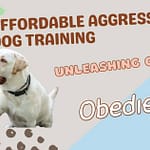Aggressive dog board and train programs can be a lifeline for pet owners struggling with damaging behaviors like thrusting, grinding, or territorial attack. Imagine this: In 2025, a German Shepherd named Max in Austin, Texas, attacked a neighbor, leaving his family desperate for solutions. After a 4- week board and train program with certified behaviorist Dr. Sarah Thompson, Max transformed into a calm, obedient companion. Stories like Max’s aren’t just luck- they are the result of science-backed training, patience, and expertise.
But how do these programs actually work? Are they safe? And how do you choose the right one? In this guide, you’ll learn everything about aggressive dog board and train options, including insider tips from trainers, red flags to avoid, and the latest methods (updated for 2025) to ensure long-term success. Let’s dive in.

What is Aggressive Dog Board and Train?
In board-and-train programs, dogs stay in a facility where they get close attention from professional trainers for intensive training. This program is really helpful for aggressive dogs, as they require constant attention with special techniques and a controlled environment.
Why does this method work?
- Hands-on training by experts.
- Change unwanted dog behaviors by focusing on them.
- Socialization opportunities are under control.
- Takes the distractions out of the dog’s home set and allows them to focus fully on their training.
How Aggressive Dog Board and Train Programs Work
The Science Behind Board and Train
These immersive programs remove your dog from triggers and pair them 24/7 with expert trainers. Unlike basic obedience classes, they focus on:
- Desensitization: Gradually exposing dogs to stressors (e.g., other dogs, loud noises).
- Counter-Conditioning: Rewarding calm behavior (using treats, toys, praise).
- Obedience Foundations: Reinforcing commands like “leave it” or “place.”
Real-Life Example: Luna, a rescue Pit Bull in Miami, would snap at anyone approaching her bowl. After a 3-week program, she learned to “wait” for permission before eating- a skill her owner maintained using consistent follow-up sessions.
Can Aggressive Dogs Be Trained?
Understanding Aggression in Dogs
Understanding Aggression in Dogs. Not all aggression is made equal, and comprehending what type of aggression your dog is exhibiting is important when trying to tackle the issue.
Common types of dog aggression:
- Territorial aggression: The dog is protective of space.
- Fear aggression: Acting out when afraid.
- Protective aggression: Protection of their owner or pack.
- Possessive aggression: Guarding of food, toys, or other objects.
- Diverted aggression: Joining out at someone cos they can’t get to the source of their frustration.
Can a Food- Aggressive Dog Be Trained?
Food aggression, described as a dog growling, barking , or even biting while defending its meal, is one of the hardest behaviors to handle. With patience and proper method, it is controllable.
How to Approach Food Aggression:
- Start by gradual desensitization: Approach your dog while he is eating, offering something positive, such as treats.
- Never punish aggressive behavior; instead, reinforce positive behavior
- Establish a definite, concrete feeding schedule that your dog can rely on
- Train “leave it” behaviors to instill in them trust that nobody will snatch their food away from them for no good reason
Best Board and Train for Aggressive Dogs
Top Features to Look For
When opting for a board and train program for your aggressive dog, not all of them share the same worth. Here’s what to look for:
- Certified and highly experienced trainers specializing in aggression.
- Tailored training programs are designed specifically to suit the unique needs of your dog.
- Centered on reward-focused positive reinforcement, rather than punishment methods.
- Safe environments are designed to minimize stress and anxiety.
- Aftercare plans are implemented to ensure training will certainly stick when your dog returns home.
Dog Board and Train in Washington State
There are several highly reputed facilities for aggressive and reactive dogs in Washington State. Their programs are designed to ensure long-term changes in both the dog and the owner.

Examples of facilities in Washington State:
- Pawsitive Dog Training: They offer aggression rehab.
- Dog’s Best Friend: They have programs for reactive and aggressive dogs, made to fit their needs exactly.
- Canine Behavior Center: They offer in-depth board-and-train services for dogs with serious behavioral issues.
Board and Train for Reactive Dogs
Aggression and reactivity are often interchanged as if they were the same, but they are not. While aggressive dogs make an intent to harm, reactive dogs simply overreact to their stimuli-be those other dogs, loud noises, or anything else.
Differences Dog Training:
- Reactive dogs profit by learning to manage triggers.
- Aggressive dogs must receive behavior modification in order to cease dangerous behaviors.
- Programs for reactive dogs tend to focus on returning a calm response to a trigger.
The Aggressive Dog Board and Train Cost
What Factors Affect the Cost?
Prices vary a lot depending on a variety of factors regarding aggressive dog board-and-train programs, including:
- Location – facilities in high demand areas are more expensive.
- Duration – the longer the dog will have to stay, the higher the cost.
- Specialization – programs that deal with extreme aggressiveness are usually way more expensive due to the special training needed.
- Aftercare services – additional sessions might be offered by some programs; this increases the price.
You can expect to pay from $1,000 to $3,000 a week, depending on these factors.
How to Board an Aggressive Dog
Steps for Safely Boarding Aggressive Dogs
Boarding an aggressive dog is tricky, but can be done with the right precautions.
Here are a few tips:
- Find a facility with knowledge in managing aggression: This means that the staff has been properly trained in the handling of aggressive dogs.
- Always be fine about your dog’s behavioral issues: If your dog exhibits aggression, you need to mention this to the personnel at the boarding facility before going ahead.
- Pertain to specific instructions concerning your dog’s triggers and how they are best handled.
- Bring comfort items along: Allow your dog to bring some comfort items with them, like his or her favorite blanket or toys, to help overcome anxiety.
Can Training Help an Aggressive Dog?
Yes, of course! Aggressive dogs can surely be helped with training, as many success stories show.
E.g.: Success Stories
- How a once-aggressive dog has learned to walk nicely on a leash.
- The dogs that would previously snap at people now patiently sit at greetings.
- Dogs with food aggression can eat peacefully around other pets, etc.
Aggressive Dog Board and Train Complaints
Common Complaints
As many owners have realized success with this approach to training, some very common complaints regarding board and train dog programs are as follows:
- Behavior coming back: Sometimes this behavior reappears after the dog gets home.
- Too expensive: The price of such programs may be too much to bear for some people.
- Miscommunication: Some believe they aren’t informed well enough about the methods of training.
How to Avoid Problems
Tips for success:
- Research: Read reviews, speak with previous clients.
- Ask what methods they use to train: They should coincide with your philosophy
- Ask about aftercare: Follow-up sessions or home-based training is essential to continued progress
How Do You Train a Hyper and Aggressive Dog?
Training a hyperactive and aggressive dog is such a delicate balance between managing their energy and dealing with their aggression.
Key Strategies:
- Obedience training is a preliminary necessity to bring the dog under control.
- Reward calm behavior through positive reinforcement.
- Provide plenty of exercise and mental stimulation during daily activities to enable him to get rid of excess energy.
- Work on his triggers of aggression by desensitization and counter-conditioning.
Conclusion
Aggressive dog board and train programs can be life-changing experiences for you and your dog. With the right facility, a good team of trainers, and an adherence to the process, you can witness aggressive behavior seriously curtailed or even eliminated.
Training is a journey-not a quick fix. And yes, even an aggressive dog can be taught to live a much calmer and safer life, with persistence and professional guidance.
Frequently Asked Questions
1. How long is dog training for an aggressive dog?
It all depends on the severity of the aggression, but most programs last any-where between 2 to 8 weeks.
2. Can board and train really fix my dog’s aggression?
While it can make a very big difference, it would usually require re-inforcement continued at home for its long-term success.
3. How do I know if my dog is a good candidate for board and training?
Board and train can be the right solution if your dog ‘s aggression is making daily life hard to deal with .
4. What am I supposed to pack for boarding an aggressive dog?
It will be very helpful if you can pack some familiar things that your dog loves, like a favorite blanket of theirs, toys, and any medication they take. These things will make them comfortable and less anxious during their stay.
5. Are there risks associated with the boarding and training programs regarding aggressive dogs?
There are some, such as your dog not fitting in or being stressed; a good facility with experience in aggression training will minimize such factors.
6. How do I reinforce the training upon my dog’s return?
Be consistent. Stick to the methods applied in training, continue positive reinforcement, and follow any aftercare from the trainers to further solidify the good behaviors learned.



